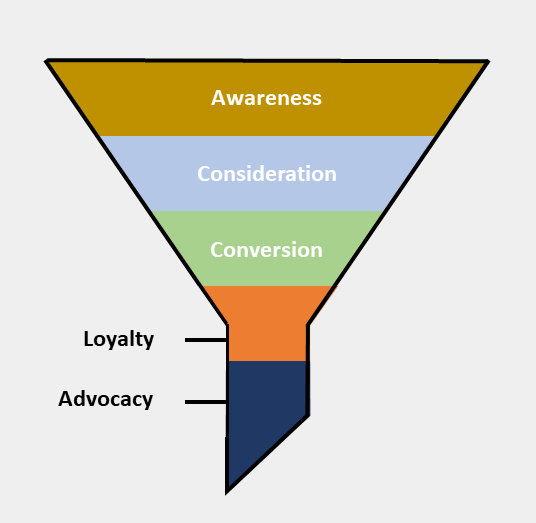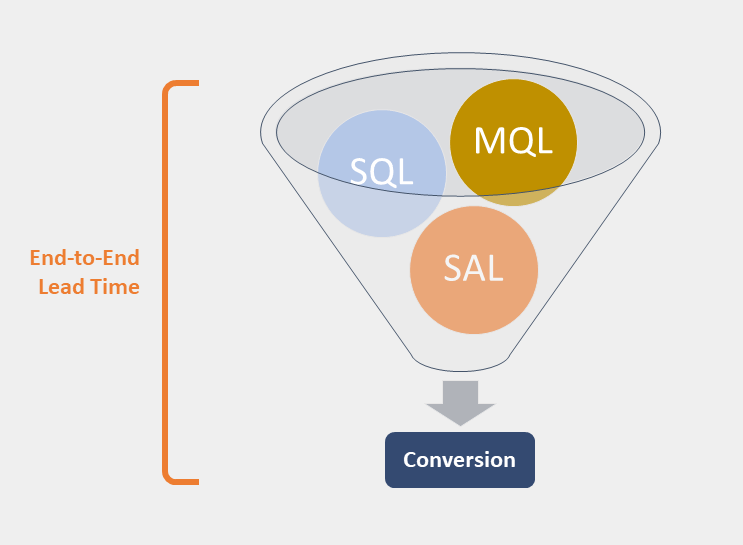This article is part 2 introducing the marketing funnel of the metrics mini-series on sales and marketing.
The marketing funnel
Attracting customers can be organized by preparing every step of the customer’s process before engaging in action. The creation of an effective marketing funnel is based on a good definition of the customer journey. It starts with getting your customer to know your brand up to making them active ambassadors.

Let’s take a look at a company in the e-commerce sector to see how the funnel generates leads.
Awareness
Inbound and outbound marketing combined with word-of-mouth advertising help improve knowledge of the brand, so more of the target audience is aware of what the brand stands for and offers, helping them to take the next step to consideration.
An e-commerce company is likely to use a mixture of marketing strategies, including targeted banners, online adverts, email mailings, and offline adverts. The company could also encourage purchasers to share details of their purchase with their friends on their social media channels and follow-up purchasers to ask for reviews, all of which helps word-of-mouth advertising.
Consideration
At this stage, potential customers look for more information about the company and the results they deliver. It often involves customers visiting the website, reading reviews, and evaluating testimonials. Clear call to actions (CTA) help direct the visitor towards conversion, the next step.
When it comes to the consideration stage for an e-commerce company, potential customers are interested in the experiences of others, especially their friends. This comes in the form of reviews and recommendations of both the product/service and the e-commerce company itself.
Conversion
This step turns the potential customer into a paying customer and includes techniques to reassure customers that they are making the right choice. For example, a free trial, free shipments and/or returns, an informative FAQ, an approachable contact service, and customer testimonials.
An e-commerce company can use any of these techniques, as well as emails that confirm the order, share tracking details, and follow-up with customers after delivery.
Loyalty
The last step encourages customers to become repeat customers. This is achieved by offering the right balance of price, value, and service throughout the funnel, from first contact to after sales.
E-commerce companies achieve brand loyalty by delivering on their promises and ensuring continual good service and follow-up.
Metrics and tracking the funnel
After determining the marketing strategy, we need to focus on the marketing funnel that moves the target audience from being informed to conversion into paying customers.
Just like for our marketing strategy, there are also metrics to help optimize the results of the funnel.

Leads conversion rate
The percentage of leads that convert into customers or users. It indicates how successful your business is in attracting the right type of audience and how well you can convert your target audience into leads.
Customer acquisition cost (CAC)
The cost to acquire each customer. See our blog on SaaS metrics for more details.
End-to-end lead time
The length of the customer journey, in other words the time it takes for the customer to move through the entire funnel, from start to end.
Marketing qualified lead (MQL)
A lead that has shown interest in a brand due to its marketing efforts. MQLs usually appear early in the funnel, as the leads are aware of the brand’s products but have not yet shown much, if any, interest in purchasing. By gaining insight into these leads, you get a better view of your current audience. Sales teams are more effective when they focus on MQLs compared to all potential leads.
Sales qualified lead (SQL)
This is an MQL that the sales department has determined to be a potential customer as they have shown an active interest in the product by requesting more information or a quote, etc. Leads only become SQLs when salespeople contact them and qualify them.
Sales accepted leads (SAL)
This is an MQL that has been reviewed and forwarded to the sales team for approval and further investigation. It creates an immediate feedback mechanism that ensures alignment between the marketing and sales team. When both departments agree on the definition of a good lead, the acceptance rates from MQL to SAL should be at least 90%.
Qualified lead velocity rate (LVR)
This is the growth rate of qualified leads per month which shows the growth and efficiency of the funnel. This indicates how many (quality) potential customers you are currently trying to convert into actual customers. If your pool of qualified leads is increasing in a reliable manner, it is a good sign of future growth and a solid foundation for accurate growth planning that relies less on estimates.
Cost per click lead velocity
This is the actual price you pay for each click in a marketing campaign, where a click represents a visit to your product page or interaction with your product. Your ROI is determined by how much pay for clicks and the quality you get in return.
Revenue
This is calculated by the conversion rate, the deal size, and the number of customers.
Talk to the experts
Are you interested in discovering the difference metrics can make for your marketing and sales activities? Contact CFOrent for expert help on implementing metrics throughout your company.
This is the second article in a three-part blog series on metrics in marketing and sales. Click here to read part 1 on metrics and the marketing strategy and part 3 on how metrics assist sales.
